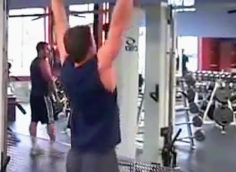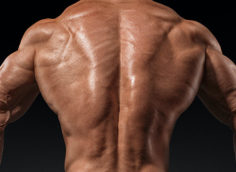A lot of lifters resign themselves to achy shoulders without realizing there's something they can do about it. Stop for a minute and fantasize about your shoulders moving freely through a full range of motion. Good fantasy, right? You can put some Marvin Gaye on and light some candles to that shit.
Fortunately, there are ways to make this a reality. Follow these five steps.
Step 1 – Fix Your Program
If you're training like a dipshit you're going to have problems. If you're solely focused on pumping up your pecs and only work the muscles you can see in the mirror, it should come as no surprise that your shoulders constantly hurt.
Even if you've perfected the bicep curl and lat pulldown, you're still probably not hitting the right pulling movements for optimal shoulder health. Don't believe it? Try this.
Shoulder Mobility Test
While standing with a neutral spine, can you lift both arms so that your biceps are even with your ears?

The first picture demonstrates a lumbar arch, which means your pecs and lats are tight so you compensate by leaning backwards. If you need to lean back like this to hit a standing press you'll have some serious lower back issues down the road to complement your shoulder pain.
If you look more like the second picture and your biceps aren't in line with your ears, then you don't possess adequate thoracic mobility. You need to add more upper body pulling exercises and do some soft tissue work along with a stretch we'll get to later.
If you resemble the third picture and can get your biceps next to your ears with your ribs pulled down, then congratulations! This is the Goldilocks zone and you're just right. But read on if you still have shoulder issues or want to prevent future ones.
Step 2 – Know The Right Ratio
Think about your daily posture. Are your shoulders hunched forward and do you have a forward neck position? Look in a mirror and see how you're standing naturally without any adjustments. Odds are that you look like the hunchback if you're being honest. Your posture says a lot about your current program.

To improve your program, shoot for 3 pulling exercises for every 2 pushing exercises. It's a 3:2 pulling-to-pushing ratio. More pulling exercises will make your posture less shitty, which will help you lift more, which will make you more jacked. Don't you want to be more jacked? Yes. Yes you do.
Make sure you include some pulling exercises every time you lift. It can be as simple as doing band pull-aparts on your pressing days between sets to make sure the shoulder stays in good alignment when you press.
In fact, always carry a resistance band with you everywhere you go in the gym. Someone on the machine you were planning to use? Do some pull-aparts while you're waiting. About to hit your next bench set? Do some pull-aparts first to help your back stay active throughout the lift. Is a hottie about to walk past you? Do some pull-aparts to keep your pump going.
Be sure to include plenty of vertical and horizontal pulling to address the entire back. Use a narrow grip when you hit your horizontal rows for your "inner" back, and a wide grip when you're trying to work your "outer" back. Do both chin-ups and pull-ups so that your shoulders stay mobile. Use both wide and narrow grips on lat pulldowns.
Fix Your Overhead Pressing Technique
Now fix your standing overhead press. Some say you shouldn't press overhead because it's bad for your shoulders, but that's only true if you have a current injury.
If you notice that the front of your shoulder drops down and your elbow flares out, then your shoulder is about to go tits up and you're going to get some impingement. When you let your shoulder drop, your rotator cuff can become compressed under your acromion (which is a bony process of the shoulder blade).
When doing the standing press, keep the elbows up and tight to the body. Squeeze your shoulder blades together to keep your shoulder in a neutral alignment.

The next time you do a standing press, do a quick body positioning check.
The Setup
- Stand with the feet shoulder-width apart.
- Lift the chest and elbows.
- Keep your head neutral.
The Lift
- Engage the core as you slightly lean back to press the bar.
- Keep your elbows lifted as you begin your press.
- Pull the body through once the bar gets past the head.
- Shrug the shoulders up at the top of the press as you "stretch the bar."

Following these steps will increase your pressing ability and keep you from destroying your shoulders in the process.
Bench Press
Don't let your elbows flare out. The style of benching where you aim to "work the outside of your pecs" is horrific idea if you plan on keeping your shoulders healthy. There are other exercises you could use to help you isolate parts of the chest. So when you bench, think like a powerlifter and tuck your elbows in.

This will not only save your shoulders, but will also give you some beefy triceps.
The Setup
- Get your feet flat on the floor.
- Squeeze your shoulder blades together and get your back flat against the bench.
- Let your lower back maintain its natural arch.
The Lift
- Tuck your elbows in tight to your body as you lower the bar.
- Touch the bar on your lower chest.
- Press the bar in a straight line on the way back to the starting position. Think about stretching the bar as you press it up.
Step 3 – Work On Mobility
Have you ever sat on the toilet and struggled to wipe your ass? Do you struggle with reaching your seatbelt in the car? Do you fail at the overhead squat? If you answer "yes" to any of these, then you lack shoulder mobility.
The shoulder is an incredibly mobile and complex joint that needs to work with your scapula and thoracic spine (upper back). For the shoulder to function properly you must have an adequate amount of thoracic mobility. To address your mobility restrictions, begin every workout doing some soft tissue work. It'll help loosen restrictive connective tissue and increase blood flow to the areas targeted. Using a foam roller is great for general areas such as the pecs, lats, triceps and thoracic spine.
Rolling out large areas of the body serves as a detector for trigger points in the body. Once you map out where they are, then whip out the balls. A lacrosse ball tends to work well in specific areas such as the rotator cuff and between the shoulder blades. You can also use it for the lats and pecs.
Releasing the Pecs

- Place the foam roller at approximately a 45 degree angle across the body.
- Place your palm flat on the floor with the outside of your pec over the roller.
- Roll back and forth concentrating on the areas that are the most sensitive.
Releasing the Triceps

- Place the foam roller just above your elbow with your arm extended.
- Place your head on your bicep for extra pressure as you roll up towards your shoulder.
- Pause over the areas that are most sensitive.
Releasing the Lats

- Place your palm flat on the floor with the side of your body over the foam roller.
- Rock up, down, and back and forth, working your way from the shoulder to the mid portion of your side.
- Take your time on the areas that are most sensitive.
Releasing the Thoracic Spine

- Place your shoulder blades across the roller with your arms behind your head or across your body.
- Roll from the top of your neck down to your mid back while lifting your chest towards the ceiling.
- Pause over the areas that are most sensitive.
Releasing the Traps and Rhomboids

- Place one arm across the body and trace the inside of your shoulder blade with the lacrosse ball.
- Draw small circles as you work your way from the top of the shoulder blade down to the bottom.
- Pause on the areas that are most sensitive.
Releasing the Rotator Cuff

- Place one hand behind your head and place the lacrosse ball on the outside of your shoulder blade near your rear deltoid.
- Draw small circles on the wall as you work the lacrosse ball into the rotator cuff.
- Pause on the areas that are most sensitive.
Step 4 – Activate Muscles Before You Train
Once you're feeling limber, fire up your back to stabilize the shoulder before you start pressing. Use a resistance band to pull the shoulder back into proper alignment and activate your muscles.
If your gym doesn't have bands, buy one. Take it with you everywhere in the gym. Bands are cheap and will make you look like you know what you're doing in the gym. Some exercises you should do before you press include "gunslingers" for the rotator cuff, as well as horizontal and vertical pull-aparts for the back.
Gunslingers

- Place a mini band around both wrists and place your elbows next to the body.
- Keeping both elbows in tight to the body, externally rotate your shoulders so that your palms come out to the sides.
- You should feel a contraction in the back of your shoulders.
Horizontal Band Pull-Aparts


- Hold a band with your hands at shoulder width with your arms extended in front of you.
- Pull the band towards your chest as you squeeze your shoulder blades together.
- Be sure to not lift the ribcage as you pull the band to your chest.
Vertical Band Pull-Aparts

- Hold a band with your hands at shoulder width, arms extended directly above you.
- Pull the band behind the head keeping your core engaged and ribcage down.
- End your pull when your arms are parallel to the floor.
Step 5 – Stretch Post Workout
Grab a resistance band. It will place some distraction on the shoulder which is good for the joint. Distraction is a mobility technique intended to create space in a joint. It allows fluid to enter into the shoulder which can help to restore mobility.
Lats

- Place your wrist in the band and push your weight back into your hips.
- Pull your hip back as you relax your shoulder. You should feel a gentle distraction on your shoulder.
Pecs

- Place your wrist in the band and abduct your arm.
- Rotate your body away from the band. You should feel a stretch in the front of your shoulder, chest, and bicep.
Triceps

- Place your elbow in the band and grab the band.
- Take a step forward and allow the band to lift your elbow towards the ceiling.
- Pull your ribcage down as you step out and let your elbow lift.





